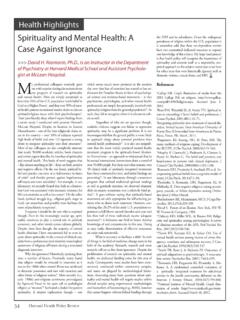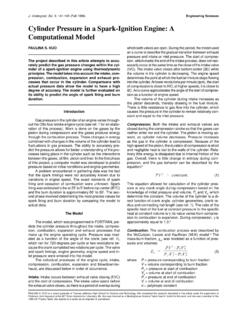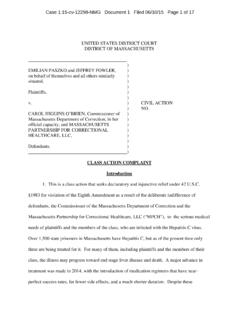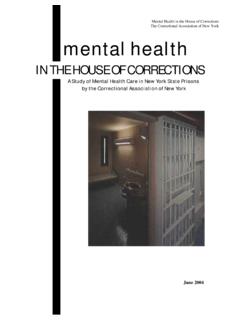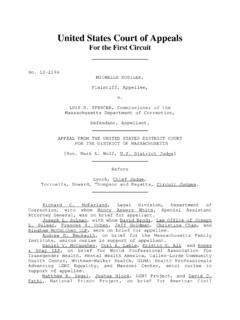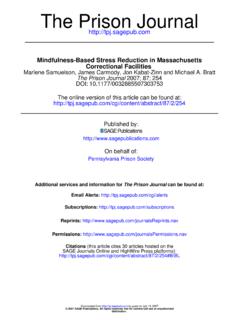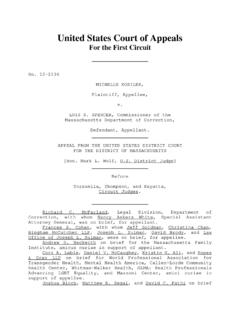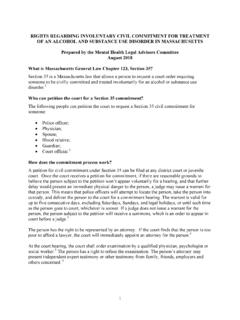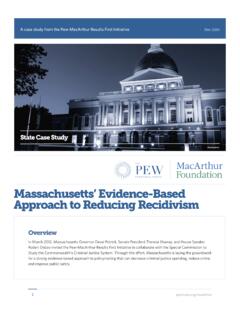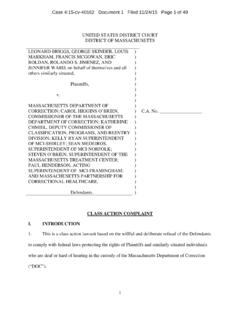Transcription of Control Unit Fact Sheet - Harvard Computer Society
1 Control unit fact Sheet WHAT ARE Control UNITS? massachusetts prisons contain Control or segregation units. The DOC Departmental Disciplinary unit (DDU) at MCI-Cedar Junction, the maximum-security prison in Walpole, is but one example of these prisons within prisons, as is the Closed Custody unit (CCU) at MCI-Framingham. A 1998 massachusetts department of correction -commissioned report identifies some common features of Control units.* Human beings are locked down in solitary confinement for 23 to 24 hours a day. When out of their cells, prisoners movement is greatly restricted by hand cuffs and ankle shackles. Visits are non-contact, and the number of visits and telephone calls permitted is severely limited.
2 Outdoor recreation takes place in individual cages that resemble slightly modified dog kennels. All meals are taken inside the cell. The availability of prison rehabilitation and work programs, recreation, clergy, and treatment providers is greatly restricted or eliminated. From 1992 to 1998, the department of correction (DOC) sent 670 male prisoners to the DDU. During this period, 123-168 people were sentenced to the DDU each year. As of 1998 the DDU contained 124 cells. The maximum-security half of the Souza-Baranowski Correctional Center in Shirley houses prisoners in conditions of total lock down for 23 to 24 hours per day, as do the segregation unit and Health Services unit in this prison.
3 Souza-Baranowski is designed to maximize Control of prisoners, including extensive checkpoints. Control UNITS ARE TORTURE CHAMBERS The United Nations has stated that Control unit conditions in the United States constitute torture. Their purpose is purely punitive, employing sensory deprivation and total isolation that leave many prisoners mentally and physically scarred. Prisoners in Control units experience no direct human contact except when being shackled by guards. Harvard Medical School psychiatrist Dr. Stuart Grassian writes, The courts have recognized that solitary confinement itself can cause a very specific kind of psychiatric syndrome, which in its worst stages can lead to an agitated, hallucinatory, confusional psychotic state often involving random violence and self-mutilation, [and] suicidal behavior.
4 Guards inflict random violence and abuse on residents of Control units. Guards in these units use especially harsh disciplinary tools to handle prisoners, including five-point restraints (shackles, * The only study ever conducted on the DDU was completed in 1998. The DOC only released this study to the public in 2002 after legal pressure was applied under the Freedom of Information Act. waist chains, and handcuffs), electronic stun devices, chemical agents, and striking instruments. Guards cuff and shackle prisoners whenever they leave their cells. According to protocol, when prisoners leave their cells, they may be strip searched, often including a cavity search, despite the fact that the prisoner may have had no contact with another human being for months.
5 Strip searches and humiliating anal probes are required before or after a visit from friends or family members, despite the fact that these visits occur through a solid plexi-glass wall, where there is no chance of contact. These practices discourage prisoners from communicating with their families and the outside world. Oftentimes, the DOC returns people who have experienced this physical and mental torture for years to the public or to the general prison population without any transitional programming or assistance. The majority of recent suicides of massachusetts prisoners investigated by advocates occurred while prisoners were in, or had recently been released from, segregation units.
6 Control UNITS ARE ARBITRARY DOC personnel can sentence prisoners to Control units for nonviolent disciplinary infractions. Prisoners may also be sent to isolation for the mere suspicion of being a security concern, not for any specific infractions. Prison authorities may confine prisoners in Control units if they are identified as members of a gang. The definition of gang is extremely vague. In massachusetts , the DOC has sent prisoners to the gang block merely for associating with gang members. Cultural symbols are often considered as evidence of gang membership, and the DOC has identified gangs, or Security Threat Groups, with only one member. There are no written guidelines for DDU sentence lengths.
7 Guards designated as Special Hearings Officers determine sentencing. The time spent in the DDU can be extended if inmates fail to follow the guidelines of the Control unit or receive disciplinary reports. The average DDU sentence in 1997, the last year for which figures are available, was months. Sentences can extend beyond 15 years, and one prisoner has been assigned to the DDU for 25 years. Prisoners do not receive credit for time served in the DDU during months in which they receive a disciplinary report or do not attend their monthly review. As of September 5, 1998, two prisoners had received no credit for more than four years spent in the DDU, and four others had spent more than double their original sentence.
8 Control UNITS ARE RACIST The general prison population of the state and of the nation is already racially disproportionate, but racial disparity is even greater in Control units. African-Americans comprise of the population of massachusetts , but according to 1998 statistics, African-American males make up 29% of the general prison population of massachusetts and 50% of those incarcerated in the DDU. of massachusetts is Latina/o, but as of 1998, 21% of the prison population was Latina/o. 19% of DDU residents are Latino. While people of color make up of massachusetts , they account for 51% of the prison population and 70% of those in the DDU. The DOC has never conducted a detailed study of the CCU, the segregation unit for women at MCI-Framingham, despite 12 reported suicide attempts there between December 2001 and June 2002.
9 Control UNITS ARE A WASTE OF PUBLIC FUNDS The cost of massachusetts Control units ranges from $90,000 to $120,000 per prisoner per year. The nationwide construction of Control units within prisons and Control unit prisons, also known as supermax prisons, has grown in the past decade. No extensive research has been done on the effectiveness or cost of such programs. The use of Control units in massachusetts is part of a nationwide trend toward harsher prison conditions. In 1983, the federal prison at Marion was placed under lock down for three years, during which time the Federal Bureau of Prisons converted the facility into a disciplinary unit . Since that time a Marionization of the prison system has taken place.
10 There are now at least 57 supermax facilities nationwide with a capacity to house more than 13,000 prisoners, and there is a disciplinary unit which functions on a segregation model within the walls of every prison and jail. SHUT DOWN THE Control UNITS! The Campaign to Build Safer Communities asks you to join us in the fight to shut down these torture chambers. Participants in this campaign include American Friends Service Committee, American Civil Liberties Union of massachusetts , Criminal Justice Policy Coalition, Critical Resistance, Friends and Families of Prisoners, League of Women Voters of massachusetts , Onestand, Partakers, Inc., the Stanley Jones Clean Slate Project and the Harvard Progressive Advocacy Group.
